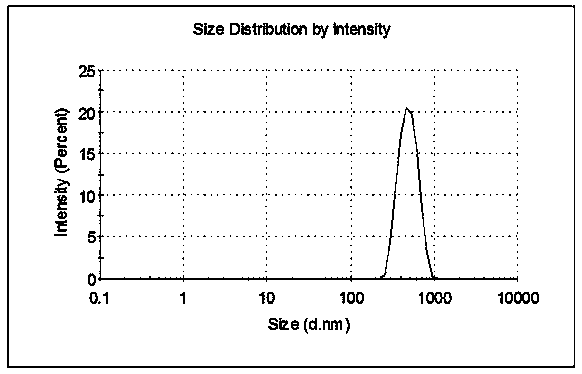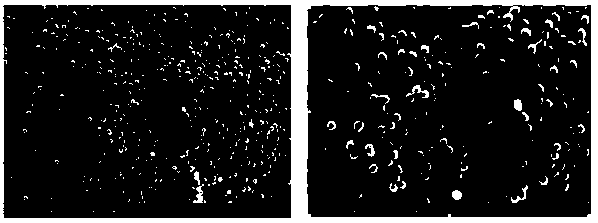DNA fixed nano hydrogel microsphere and preparation and application of DNA fixed nano hydrogel microsphere and nucleic acid aptamer compound
A nano-hydrogel and nucleic acid aptamer technology is applied in the directions of medical preparations without active ingredients, medical preparations containing active ingredients, and pharmaceutical formulas, which can solve complex and expensive, complicated and complicated post-processing and purification, combined with Insufficient stability and other problems, to achieve the effect of simple preparation process, good tolerance to different temperatures, and mild reaction conditions
- Summary
- Abstract
- Description
- Claims
- Application Information
AI Technical Summary
Problems solved by technology
Method used
Image
Examples
Embodiment 1
[0065] (1) Synthesis of Acrydite-DNA
[0066] Weigh 6-amino-1-hexanol (1.0g, 8.1mmol) into a 50mL round bottom flask, then add 10mL of anhydrous CH 2 Cl 2 Dissolve 6-amino-1-hexanol, measure anhydrous triethylamine (2.4mL, 17mmol), add it dropwise to the reaction solution, put the round bottom flask in ice bath for 15min, slowly add methacryloyl chloride (2.5 mL, 25mmol), reacted for 4 hours, and used saturated NaHCO 3 Extract with saturated NaCl three times each. The lower organic phase was removed by rotary evaporation to remove the solvent, then 10 mL of absolute ethanol was added to dissolve the sample, and then newly prepared NaOH solution (4 mL 15%, 15 mmol) was added to continue the reaction for 2 hours. After the reaction was completed, the solvent was removed by rotary evaporation and 25mL CH 2 Cl 2 The solution was dissolved, respectively, with 8 mL of saturated NaHCO 3 Extract with saturated NaCl three times, and then remove the solvent by rotary evaporation t...
Embodiment 2
[0076] Example 2 Investigation on the degradation performance of reduction-sensitive PMAA nano-hydrogels
[0077] First, 12 mg of DNA-PMAA nanohydrogel was weighed, dispersed and dissolved in 40 mL of PBS pH 7.4 buffer solution, and then 6 parts of the above solution were weighed, each 6 mL in a vial. Number the six vials 1, 2, 3, 4, 5, and 6 respectively. Then add reducing agent DTT 3mg, 5mg, 8mg, 10mg, 15mg, 20mg into the vials numbered 1, 2, 3, 4, 5, 6 respectively. After dispersing and dissolving, take a sample of 100 μL every 5 minutes in a water bath at 37°C, and use an ultraviolet spectrophotometer UV-2700 to detect its light transmittance T%. The experimental results are shown in Figure 4 .
Embodiment 3
[0078] Example 3 Fluorescence detection experiment after connecting complementary DNA strands to the surface of PMAA nanohydrogel
[0079]In this experiment, the DNA fluorescent dye SYBR combined with single-stranded DNA to display pink fluorescence, combined with the principle of double-stranded DNA to display green fluorescence, were used to analyze the single-stranded DNA modified PMAA nano-hydrogel and the T-DNA complementary to the gel surface DNA (sequence Validation for 5'-TTT TTT TTT TTT TTT TTT TT-3') bound hydrogel microspheres. Firstly, 3 parts of PMAA nanohydrogels covalently modified by single-stranded DNA were weighed, 3 mg each, and 140 μL of PBS pH7.4 buffer was added respectively, and named as: Group A, Group B, and Group C. Then add 20 μL PBS buffer to group A and group B respectively, add 20 μL 0.05 mM T-DNA complementary to DNA on the gel surface to group C, then continue to add 20 μL PBS buffer to group A, and add 20 μL PBS buffer to group B and C respecti...
PUM
 Login to View More
Login to View More Abstract
Description
Claims
Application Information
 Login to View More
Login to View More - R&D
- Intellectual Property
- Life Sciences
- Materials
- Tech Scout
- Unparalleled Data Quality
- Higher Quality Content
- 60% Fewer Hallucinations
Browse by: Latest US Patents, China's latest patents, Technical Efficacy Thesaurus, Application Domain, Technology Topic, Popular Technical Reports.
© 2025 PatSnap. All rights reserved.Legal|Privacy policy|Modern Slavery Act Transparency Statement|Sitemap|About US| Contact US: help@patsnap.com



